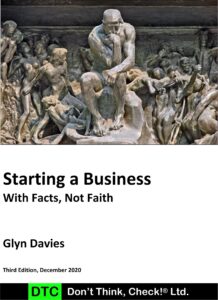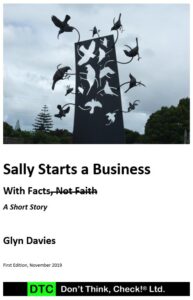Starting A Business – With Facts, Not Faith
Hi,
Glyn with a ‘y’ from Don’t Think, Check!® Limited again.
This is the fourth episode in a series called Starting A Business – With Facts, Not Faith.
In this episode, I introduce the Seven Factors For Success, which if you consider seriously, will go a long way to help you with your success.
And by success I mean, that you either successfully start and scale up a business or that you learn something and stop before you lose all your money.
Seven Factors For Success (SFFS)
There many things you need to get right to start and then run a business. I’m cynical about many of the 5-point or 11-point lists to nirvana that every author seems to provide.
My issue with the answer to all your problems meme in only a few steps and 3 easy payments, is that it is manipulative. But lists work to get your attention as they satisfy our needs for simple, or should that be simplistic? solutions to complex problems.
Instead, I provide you with the first 7 factors for success that you need to have.
There are probably thousands, but let’s start with 7:
In the Seven Factors For Success, I mention something called Job To Be Done, also known as a problem to be solved.
I’ll define what I mean by the term Job To Be Done first so that hopefully the list of Seven Factors For Success might make more sense.
Jobs To Be Done
Many people talk about customer problems to be solved, but not all things that customers want to solve are problems as such. Is wanting to entertain your partner with a meal or a movie a problem? Perhaps not; at least you wouldn’t admit as much, twice.
Clayton Christensen has researched what customers are trying to achieve and has written about Jobs To Be Done, where, a job is defined as the progress that a customer desires to make in a particular circumstance.
From Competing Against Luck, by Clayton Christensen, the Theory of Jobs to Be Done requires that we:
- Focus on deeply understanding the customers’ struggle for progress, in specific contexts,
- Understand the trade-offs the customers’ are willing to make, the set of competing solutions that must be beaten, and the anxieties that must be overcome,
- Create the right solution system with an attendant set of experiences, that satisfies the customers’ functional, social, and emotional requirements, that is, that solves the customers’ jobs well, every time,
- Understand that it is not about products [or services] as such.
So that concludes the definition for Job To Be Done. Re-read it until you have memorised it. Seriously.
Finally, we’ve made it to the list of Seven Factors For Success.
I’ll go through the list first, and then I’ll explain what it all means.
- There has to exist a Job To Be Done (problem to be solved), AND
- You need to develop a complete Solution (a product, service, and experience bundle) for that Job To Be Done, AND
- Prospective Customers need to recognise that they have a Job To Be Done and agree that your Solution is the best alternative that they are aware of (doing nothing is an alternative), AND
- Prospective Customers must be prepared to pay the price that you need to both ensure your business’s success and to achieve your goals (sell price greater than costs, and then some), AND
- Prospective Customers must exist in enough numbers, AND
- Customers must be so pleased with your Solution, that they are prepared to advocate on your behalf, to in effect, sell your Solution for you – satisfied customers are not necessarily loyal and nor are they sufficient, you need advocates, AND
- You need to develop the capability of Enduring Transient Competitive Advantage as no competitive advantage is sustainable in the long term.
There are thousands of other things you must do and get right, but if you can’t get those first five and then the sixth and seventh right, then give up now.
Let’s work through the list and explain what it means:
- Job To Be Done – you need to provide a solution for an existing underlying if not explicit need. Your solution needs to be more than just your great idea. Steve Blank said it well, “[b]uild it and they will buy is not a strategy, it is a prayer,” “you cannot create a market or customer demand where there isn’t customer interest.” The Four Steps to the Epiphany.
- Complete Solution – the solution you provide needs to be complete, that is, your solution needs to provide the complete benefit-set that customers are looking for. Half a solution or a badly delivered complete solution will not be good enough.
- Prospective Customers Agree – customers not only need to agree that their need is important enough that they are willing to pay to have that need satisfied, but they also need to agree that your solution provides the best value benefit-set amongst the options they are aware of, and doing nothing about their need is an option.
- Prospective Customers Prepared To Pay – prospective customers must value your solution’s benefit-set so much, that they are willing to pay you for it – customers buy benefits, not features. And the price customers pay must cover all your costs and also provide you with the profit you need to achieve both your business and personal goals.
- Prospective Customers Exist In Sufficient Numbers – the population of potential first-time customers and repeat customers needs to be large enough to sustain your business long-term. You might get to this point in the list of factors and find that the population will only support 100 first-time and 20 repeat customers per year, but if you need 200 and 100 respectively, then you have a Business Model sustainability problem.
- Customers Advocate on your behalf – traditional advertising is expensive and bubbling to the top of the social media attention pool is hard. Ultimately, while some advertising might be required to attract attention, the best and cheapest promotional activity is through word-of-mouth advocacy.
- Enduring Transient Competitive Advantage – as the world is constantly changing, it is difficult to sustain a competitive advantage for as long as you would prefer. Instead of trying to achieve sustainable competitive advantage, you need to build into your Business Model the enduring capability of achieving successive periods of transient competitive advantage.
So there you have it. To be successful with your solution, you need to look deeply at what progress customers are trying to make in their particular circumstances. If you do not first completely understand their Job To Be Done and then provide a complete solution you will not be successful long-term.
For your convenience, I have provided The 1-Page Business Model and handbook.
So to summarise:
- If you don’t know what is required to play your game, get off the court!
- If you can’t do or achieve what is required to play your game, get off the court!
In the next episode, I will be talking about Business Models and Summarise what we have covered.
#DontThinkCheck #BusinessResultant #StartMyBusiness #RunMyBusiness #SeeANeedFillANeed



